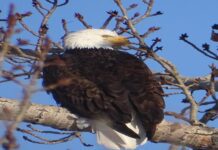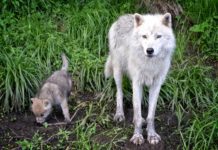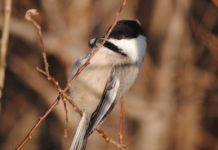Article by J.G. Turner
In 2016, the Royal Canadian Geographical Society asked Canadians to identify candidates for an ‘official’ bird for Canada, intending to lobby the Canadian Government to make the final choice official to mark Canada’s 150th birthday in 2017. The winner was the Grey Jay which is also known as the Gray Jay, the Canada Jay, the Whisky/Whiskey Jack, the Camp Robber, the Meat Hawk and the Moose Bird.
The Grey Jay is the only grey coloured Jay in North America and is 28 to 33 cm (11 – 13 in) from beak to tail’s tip, has a 45 cm (18 in) wingspan and weighs about 70 g (21.5 oz) The Grey Jay is a large fluffy grey bird with white head, black nape, short black bill, and long tail but no head crest. It has variations in its colouring in different regions and is often visually confused with Northern and Loggerhead Shrikes. This mischievous bird lives year-round in every province and territory of Canada, thriving in cold temperature extremes (up to -30 C). The Grey Jay is found in boreal regions from the tree limit in the far north through mountains and foothills, coniferous and mixed forests, bogs and fens, picnic and campsites across the country.
Fun Facts:
- The Grey Jay is a member of the corvidae family of birds, along with other jays, crows, magpies and ravens. This is a highly intelligent group of birds known for their boisterousness, persistence and adaptability to the presence of humans in their environment. The Grey Jay is said to have the same “brain to body size ratio” as dolphins and chimpanzees!
- These birds are of the earliest nesters in Alberta, laying eggs as early as late February. This gives their young most of the year to learn to forage and store food for their first winter.
- Grey Jays are omnivores and eat seeds, scavenge carcasses (part of nature’s clean up crew), and eat eggs and nestlings of other birds.
- Grey Jay cold weather adaptations include:
- catching small chunks of food by covering it with their sticky saliva, and ‘gluing’ the food to tree trunks, twigs or conifer needle clusters. The Grey Jay remembers where it stores this food!
- allowing solar radiation to penetrate their feathers while still keeping their insulating qualities; and
- decreasing their body temperature at night.
- You may be able to attract the Grey Jay to your backyard feeder with suet, rolled oats, shelled sunflower seeds, or dry dog and cat food.
If you find an injured or orphaned wild bird or animal, please contact the Calgary Wildlife Rehabilitation Society at 403-239-2488 for tips, instructions and advice, or look at the website at www.calgarywildlife.org for more information.










